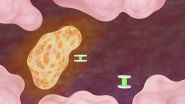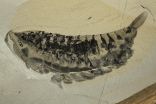(Press-News.org) The promising new material molybdenum disulfide (MoS2) has an inherent issue that's steeped in irony. The material's greatest asset--its monolayer thickness--is also its biggest challenge.
Monolayer MoS2's ultra-thin structure is strong, lightweight, and flexible, making it a good candidate for many applications, such as high-performance, flexible electronics. Such a thin semiconducting material, however, has very little interaction with light, limiting the material's use in light emitting and absorbing applications.
"The problem with these materials is that they are just one monolayer thick," said Koray Aydin, assistant professor of electrical engineering and computer science at Northwestern University's McCormick School of Engineering. "So the amount of material that is available for light emission or light absorption is very limited. In order to use these materials for practical photonic and optoelectric applications, we needed to increase their interactions with light."
Aydin and his team tackled this problem by combining nanotechnology, materials science, and plasmonics, the study of the interactions between light and metal. The team designed and fabricated a series of silver nanodiscs and arranged them in a periodic fashion on top of a sheet of MoS2. Not only did they find that the nanodiscs enhanced light emission, but they determined the specific diameter of the most successful disc, which is 130 nanometers.
"We have known that these plasmonic nanostructures have the ability to attract and trap light in a small volume," said Serkan Butun, a postdoctoral researcher in Aydin's lab. "Now we've shown that placing silver nanodiscs over the material results in twelve times more light emission."
The use of the nanostructures--as opposed to using a continuous film to cover the MoS2--allows the material to retain its flexible nature and natural mechanical properties.
Supported by Northwestern's Materials Research Science and Engineering Center and the Institute for Sustainability and Energy at Northwestern, the research is described in the March 2015 online issue of NanoLetters. Butun is first author of the paper. Sefaatiin Tongay, assistant professor of materials science and engineering at Arizona State University, provided the large-area monolayer MoS2 material used in the study.
With enhanced light emission properties, MoS2 could be a good candidate for light emitting diode technologies. The team's next step is to use the same strategy for increasing the material's light absorption abilities to create a better material for solar cells and photodetectors.
"This is a huge step, but it's not the end of the story," Aydin said. "There might be ways to enhance light emission even further. But, so far, we have successfully shown that it's indeed possible to increase light emission from a very thin material."
INFORMATION:
Scientists working at the National Institute of Standards and Technology (NIST) and the National Institutes of Health (NIH) have devised and demonstrated a new, shape-shifting probe, about one-hundredth as wide as a human hair, which is capable of sensitive, high-resolution remote biological sensing that is not possible with current technology. If eventually put into widespread use, the design could have a major impact on research in medicine, chemistry, biology and engineering. Ultimately, it might be used in clinical diagnostics.
To date, most efforts to image highly ...
March 27, 2015 - For people with low vision who need bioptic telescopic glasses to drive, previous driving experience and the need for more training hours are the main factors affecting performance on driver's license road tests, according to a study in the April issue of Optometry and Vision Science, official journal of the American Academy of Optometry. The journal is published by Wolters Kluwer.
After driving experience is taken into account, visual factors have no significant effect on road test scores in drivers using bioptic devices, report Bradley E. Dougherty, ...
Cold snaps like the ones that hit the eastern United States in the past winters are not a consequence of climate change. Scientists at ETH Zurich and the California Institute of Technology have shown that global warming actually tends to reduce temperature variability.
Repeated cold snaps led to temperatures far below freezing across the eastern United States in the past two winters. Parts of the Niagara Falls froze, and ice floes formed on Lake Michigan. Such low temperatures had become rare in recent years. Pictures of icy, snow-covered cities made their way around ...
University of Notre Dame applied mathematician Mark Alber and environmental biotechnologist Robert Nerenberg have developed a new computational model that effectively simulates the mechanical behavior of biofilms. Their model may lead to new strategies for studying a range of issues from blood clots to waste treatment systems.
"Blood clotting is a leading cause of death in the United States at this point," said Alber, who is The Vincent J. Duncan Family Professor of Applied Mathematics in the College of Science and an adjunct professor of medicine at the Indiana University ...
TEMPE, Ariz. (March 27, 2015) - As more people move to different regions of the country it will require planners to use as many tools as they can to develop urban areas that satisfy population demands and not over burden the environment.
A new study from Arizona State University (ASU) details some of the dynamics at play as one region of the country, the Central Valley of California, braces for substantial population growth and all it entails. The study, based on computer simulations using the ASU Advanced Computing Center, of rural to urban land conversion shows that ...
March 27, 2015--A study by researchers at Columbia University's Mailman School of Public Health and colleagues in the Netherlands evaluated the relationship between nutritional conditions in very early life and adult health, and found that famine exposure during the first pregnancy trimester was associated with increases in mortality from a variety of causes other than cancer or cardiovascular disease.
This is the first study to quantify the possible long-term effects of nutrition deprivation at different stages of pregnancy and long-term mortality from causes of death ...
BUFFALO, N.Y. - A big bowl of mashed potatoes. What about spaghetti and meatballs? Sushi? Regardless of what you identify as comfort food, it's likely the attraction to that dish is based on having a good relationship with the person you remember first preparing it, according to the results of a new study by a University at Buffalo research team.
The findings have implications for better understanding how social factors influence our food preferences and eating behavior.
"Comfort foods are often the foods that our caregivers gave us when we were children. As long we ...
Milan, Italy - March 28, 2015 Research looking at risk of early mortality of British middle-aged women and osteoarthritis was presented today at the World Congress on Osteoporosis, Osteoarthritis and Musculoskeletal Diseases. It shows that any painful knee osteoarthritis is strongly associated with early overall and cardiovascular mortality. Interestingly these findings are independent to most of the known risk factors linked with early mortality. The study was based on the data from the Chingford Study. This is community based data from a cohort of middle-aged women followed ...
TORONTO, ON - What do butterflies, spiders and lobsters have in common? They are all surviving relatives of a newly identified species called Yawunik kootenayi, a marine creature with two pairs of eyes and prominent grasping appendages that lived as much as 508 million years ago - more than 250 million years before the first dinosaur.
The fossil was identified by an international team led by palaeontologists at the University of Toronto (U of T) and the Royal Ontario Museum (ROM) in Toronto, as well as Pomona College in California. It is the first new species to be described ...
Reclusive giant pandas fascinate the world, yet precious little is known about how they spend their time in the Chinese bamboo forests. Until now.
A team of Michigan State University (MSU) researchers who have been electronically stalking five pandas in the wild, courtesy of rare GPS collars, have finished crunching months of data and has published some panda surprises in this month's Journal of Mammalogy.
"Pandas are such an elusive species and it's very hard to observe them in wild, so we haven't had a good picture of where they are from one day to the next," said ...


